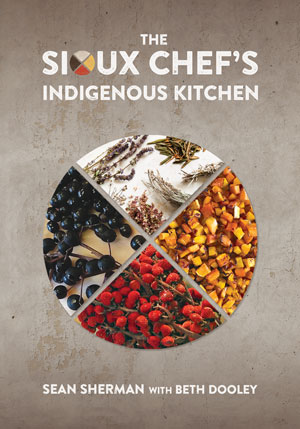
Sean Sherman’s cookbook urges us to wake up to the past and to the actual American food.
It was on a trip to Mexico that The Sioux Chef, Sean Sherman, had a revelation. Awakened to some critical truths about food and culture, he embarked on an empowering journey of culinary discovery, which is captured in his new cookbook, The Sioux Chef’s Indigenous Kitchen, written with Beth Dooley and published by University of Minnesota Press.

And from the very first page of what is arguably one of the most important cookbooks of the year, Sherman (Oglala Lakota) shares some heady stuff he’s discovered — and uncovered. That the personal and collective are one and the same. That sometimes you have to look outward to see within yourself. That the past holds truths that the present has often confused. That, given all of the above, you can set the table with a new view of real Native American food.
Family gatherings on Sherman’s grandparents’ Pine Ridge Reservation ranch had included things like Wojape (Lakota berry soup) and the prairie turnip timpsula, but the majority of the consumables in the pantry had been government-issue commodities. What passed for Native gastronomy (fry bread and Indian tacos) was also based on commodity products with roots in a dark past.
The long history of his people’s culinary traditions was nearly given up to fading memories.

Nearly given up, that is, until Sherman took a break from cheffing in Minnesota to spend time in Mexico. There he saw the sweat lodge (temescal) of the indigenous Huichol people. Their beadwork evoked memories of his own people’s craft. Connections to a collective past were everywhere.
Those connections would lead Sherman on his own path in search of a pre-European-contact past previously believed dormant. He realized a need for an “awakening” to the ancestral. Recalling his childhood and his trip to Mexico, Sherman began putting together the pieces of a culinary and cultural tradition ghosting throughout his life.
He dug into research, in search of the paper trail that would hopefully assist in stirring the past into the present.
Next, Sherman recruited farmers, artists, chefs, foragers, caterers, and ethnobiologists of various indigenous heritages to establish The Sioux Chef, a group dedicated to researching and sharing precolonial foodways, teaching about nutrition, and putting on workshops, among other food sovereignty-related projects.
A food truck was rolled out (no fry bread on the menu, thank you very much). Cooking classes were held. Catered and pop-up dinners were hosted. Piece by piece, the picture of the true American cuisine started to come into focus. The organization soon realized a restaurant should be a goal (one is planned for Minneapolis).
But first, a cookbook was in order.
That book, The Sioux Chef’s Indigenous Kitchen, is a refreshing tome that serves as the “awakening” Sherman is working toward. It’s not the first book to advance the case for a return to true Native foodways, their health benefits, and cultural importance. But The Sioux Chef’s Indigenous Kitchen could very well break through barriers to achieve wider consideration and awareness.
Although Sherman’s is the marquee name on The Sioux Chef’s Indigenous Kitchen — he is, after all, The Sioux Chef who is the face of the reclaiming of Native American cuisine — the cookbook is more than one chef’s story and lavishly photographed recipes. Rather, this is a collection of narratives and recipes from Sherman, his team, and other associates who have contributed to the movement, including chefs Brian Yazzie and Freddie Bitsoie (both Navajo) and pioneering Native American culinary anthropologist-chef Lois Ellen Frank (Kiowa). Also featured are Rich Francis (Six Nations, Ontario), whose participation in Top Chef Canada has made him a celebrity chef and garnered praise for indigenous foodways, and Andrea Murdoch, a chef of Inca ancestry.
Together they plot the elements of the original local, seasonally based foods in a series of familiar and approachable recipes supported by digestible cultural context. There’s the importance of corn, timpsula, game, and wild rice. There’s the focus on seasonal cultural events, such as feasts of the moon. There’s the outlining of native herbs and seasonings, such as cedar, staghorn sumac, and sage.
What there isn’t is anything processed — the stuff that bogs you down, makes you fat, keeps you asleep. The Sioux Chef’s Indigenous Kitchen is an important and appetizing wake-up call to what’s natural and native to America.
Recipes
Smoked Whitefish and White Bean Spread
Teas Recipes From The Sioux Chef’s Indigenous Kitchen
The Sioux Chef’s Indigenous Kitchen, by Sean Sherman, with Beth Dooley, copyright 2017, University of Minnesota Press, is available on Amazon.com.
Read more about Sean Sherman in our December 2016 issue, and read more about Brian Yazzie in our October 2017 issue.












